
A lichen is a composite organism that arises from algae or cyanobacteria living among filaments of multiple fungi species in a mutualistic relationship. Lichens are important actors in nutrient cycling and act as producers which many higher trophic feeders feed on, such as reindeer, gastropods, nematodes, mites, and springtails. Lichens have properties different from those of their component organisms. They come in many colors, sizes, and forms and are sometimes plant-like, but are not plants. They may have tiny, leafless branches (fruticose); flat leaf-like structures (foliose); grow crust-like, adhering tightly to a surface (substrate) like a thick coat of paint (crustose); have a powder-like appearance (leprose); or other growth forms.
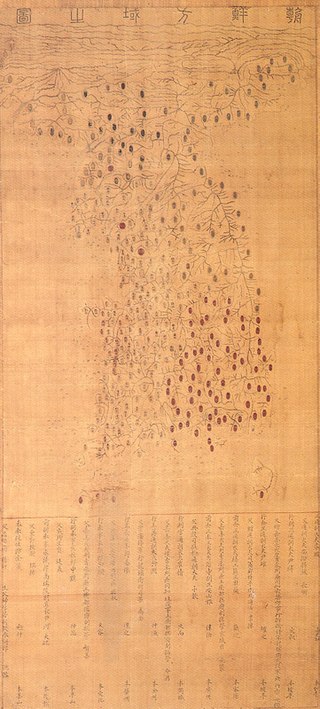
Wiman Joseon was a dynasty of Gojoseon. It began with Wiman's seizure of the throne from Gija Joseon's King Jun and ended with the death of King Ugeo who was a grandson of Wiman. Apart from archaeological data, the main source on this historical period comes from chapter 115 of Sima Qian's Records of the Grand Historian. Wiman was originally a Chinese military leader from the Kingdom of Yan under the Han dynasty.

The common redpoll or mealy redpoll is a species of bird in the finch family. It breeds somewhat further south than the Arctic redpoll, also in habitats with thickets or shrubs.

Erik Acharius was a Swedish botanist who pioneered the taxonomy of lichens and is known as the "father of lichenology." Acharius was famously the last pupil of Carl Linnaeus.

The Parmeliaceae is a large and diverse family of Lecanoromycetes. With over 2700 species in 71 genera, it is the largest family of lichen-forming fungi. The most speciose genera in the family are the well-known groups: Xanthoparmelia, Usnea, Parmotrema, and Hypotrachyna.

The Threatened Species Protection Act 1995, is an act of the Parliament of Tasmania that provides the statute relating to conservation of flora and fauna. Its long title is An Act to provide for the protection and management of threatened native flora and fauna and to enable and promote the conservation of native flora and fauna. It received the royal assent on 14 November 1995.

Umbilicaria esculenta, the rock tripe, is a lichen of the genus Umbilicaria that grows on rocks.
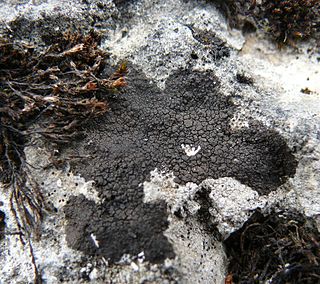
Verrucariaceae is a family of lichens and a few non-lichenised fungi in the order Verrucariales. The lichens have a wide variety of thallus forms, from crustose (crust-like) to foliose (bushy) and squamulose (scaly). Most of them grow on land, some in freshwater and a few in the sea. Many are free-living but there are some species that are parasites on other lichens, while one marine species always lives together with a leafy green alga.

Thelidium is a genus of lichen-forming fungi in the family Verrucariaceae. The genus was circumscribed in 1855 by Italian lichenologist Abramo Bartolommeo Massalongo, who assigned Thelidium amylaceum as the type species.

Foliicolous refers to the growth habit of certain lichens, algae, and fungi that prefer to grow on the leaves of vascular plants. There have been about 700 species of foliicolous lichens identified, most of which are found in the tropics.

Menegazzia terebrata is a species of foliose lichen found scattered across many continents, including North America, South America, Europe, Africa, and Asia.

The Guébriant Islands are two islands west of the Antarctic Peninsula, in the northern part of Marguerite Bay, lying 9.3 kilometres (5 nmi) southeast of Cape Alexandra, the southeast cape of Adelaide Island. They were discovered by the fourth French Antarctic Expedition 1908–1910 under Jean-Baptiste Charcot and named by him as "Îlots de Guébriant" after the Reverend Jean Budes de Guébriant, a French Catholic missionary to China.

Miriquidica deusta is a species of lichen in the family Lecanoraceae. A North American native, it generally grows on siliceous rocks. It belongs to the subdivision Pezizomycotina of the division Ascomycota, within the order Lecanorales. These are found in both general and Estonian herbariums.
William Borrer was an English botanist noted for his extensive and accurate knowledge of the plants of the British Islands.
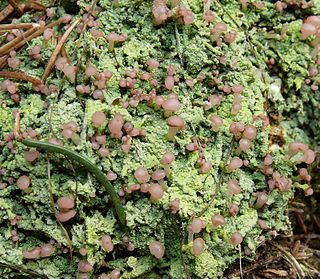
Baeomyces rufus, commonly known as the brown beret lichen, is a fruticose lichen belonging to the cap lichen family, Baeomycetaceae. The species was first described by J.F Rebentisch in 1804. Like other lichens, it is a symbiosis between a fungus and an alga.
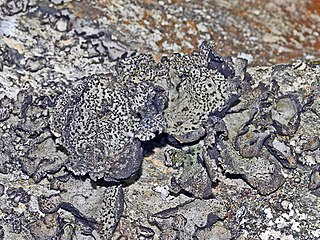
Umbilicaria crustulosa, the crusty navel lichen, is a lichen of the genus Umbilicaria in the family Umbilicariaceae.
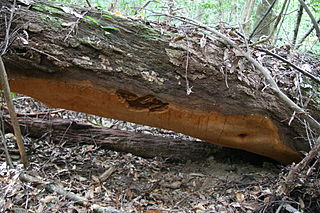
The largest mushrooms and conks are the largest known individual fruit bodies. These are known as sporocarps, or, more specifically, basidiocarps and ascocarps for the Basidiomycota and Ascomycota respectively. These fruit bodies have a wide variety of morphologies, ranging from the typical mushroom shape, to brackets (conks), puffballs, cup fungi, stinkhorns, crusts and corals. Many species of fungi, including yeasts, moulds and the fungal component of lichens, do not form fruit bodies in this sense, but can form visible presences such as cankers. Individual fruit bodies need not be individual biological organisms, and extremely large single organisms can be made up of a great many fruit bodies connected by networks of mycelia can cover a very large area.

Cladonia parasitica, commonly known as the fence-rail cladonia, fence-rail cup lichen or parasite club lichen, is a species of fruticose, cup lichen in the family Cladoniaceae. It was first described by Hoffmann in 1784 under the name Lichen parasiticus, until he reclassified it under the genus Cladonia in 1795.

Cladonia digitata, commonly known as the finger cup lichen, is a cup lichen species in the family Cladoniaceae.
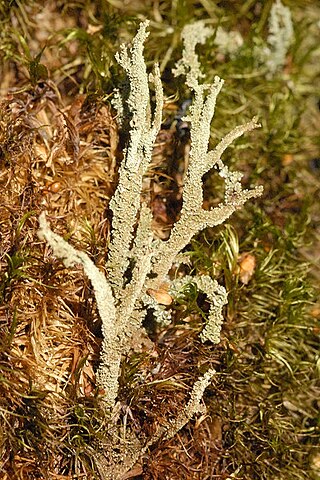
Cladonia squamosa or the dragon cup lichen is a species of cup lichen in the family Cladoniaceae.



















